There are five (5) species of toads and five (5) species of frogs in North Dakota, adding up to ten (10) anuran species in the state. This article lists all ten species, providing some additional information peculiar to each one.
Frogs and toads are small four-legged amphibians belonging to the class Anura (amphibians without tails). They are cold-blooded (ectothermic), meaning that they cannot regulate their body temperature internally to adjust to the environment.
They provide food for small mammals, snakes, otters, birds, raccoons, fish, salamanders, larger frogs, and sometimes humans. For food, they mostly eat insects, their larvae, and other noninsect arthropods (terrestrial invertebrates).
Anurans are cryptically adapted to avoid predation. Both their dorsal and ventral skins are colored to blend them into their environments. However, frogs have smoother and more moist skin than toads on average.
Their dorsal coloration saves them mostly from terrestrial and arboreal predators, while their ventral coloration saves them from aquatic ones. Other anti-predator techniques exist in frogs and toads.
Their eyes are widely spaced for wide and comprehensive vision. Their external eardrums (tympana) sense vibrations in their environment. The only sounds they are able to hear are the calls of conspecifics (other frogs of their own species).
All toads secrete a poisonous substance from warts on their rough, dry skin and their parotid glands. Most frogs are not poisonous, but with their slender bodies and long legs, they can jump, leap or swim away quickly when attacked.
Toads have shorter legs and stockier bodies so they move slower by walking or crawling. Certain frog and toad species make use of alarm calls when threatened. An alarm call is a loud cry or shriek used to startle and confuse predators.
Another way to avoid being eaten is by showing activity under the cover of the night. Most anurans are nocturnal (most active in the nighttime), but others are diurnal (most active in the daytime) or crepuscular (most active at dusk and dawn).
Listed below are the ten (10) species of toads and frogs in North Dakota with their biological family names, zoological names, other common names, adult size range, also called snout-vent length (SVL), and expected lifespan or longevity.
Also included where available are: their geographic ranges, habitats of choice, physical descriptions, behaviors, mating or advertisement calls (for males), and additional anti-predator mechanisms, all at adulthood.
Table of Contents
Species of Frogs in North Dakota
1. Boreal Chorus Frog

- Family: Hylidae
- Scientific Name: Pseudacris maculata
- Other Names: Pseudacris triseriata maculata
- Adult Size: 3 to 3.8 cm (1.18 to 1.5 in)
- Lifespan: 2 to 3 years, record longevity of 6 years
The boreal chorus frog is native and endemic to North America. It can be found in Canada and in some states of the USA. It inhabits Canadian provinces like Yukon, Ontario, British Columbia, Manitoba, and Quebec.
This frog likes to live in open spaces, forests with open canopy, grasslands, roadside ditches, splash pools, swamps, shallow lakes, flooded fields, and around other freshwater sources without fish.
Boreal chorus frogs live comfortably in habitats containing enough vegetation for cover and protection, and food in the form of insects. They are a native species in Montana. These small frogs have smooth and moist skin.
Dorsally, they can be found in any shade of color from greenish gray to brown. They have three stripes on their backs in a darker hue or shade than their dorsal color. The stripes are usually broken.
On the boreal chorus frog, there is a dark stripe from each eye to the groin. Between the eyes of individuals, a dark triangular pattern may be seen. A white stripe, as has been noticed on most chorus frogs, runs across their upper lip.
Ventrally, they are usually colored white, yellowish, or cream, and their chests and throats may be mottled. They have small pads on their toads for climbing. They have pointed snouts.
Male boreal chorus frogs use a loud, chirp-like breeding or advertisement call. It has been likened to the sound of drawing a finger down a comb’s teeth. It is called repeated maybe 30-70 times per minute.
These frogs are diurnal, nocturnal, and crepuscular. They show more daytime activity in cooler months of the year and more activity at dusk, night, and dawn in the hotter months.
They are however active both day and night during the breeding season.
2. Cope’s Gray Tree Frog
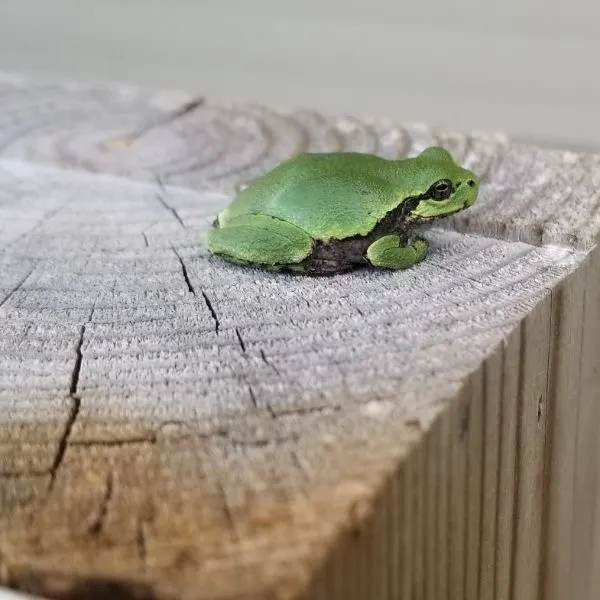
- Family: Hylidae
- Scientific Name: Hyla chrysoscelis
- Other Names: Southern gray tree frog
- Adult Size: 3.2 to 6 cm (1.26 to 3.26 in)
- Lifespan: 2.5 to 7 years in captivity
Cope’s gray tree frogs are native to North America. They live in the Canadian province of Manitoba. They can also be found in many states of the USA like Alabama, Delaware, Florida, Kansas, Michigan, Ohio, and West Virginia.
Individuals can be found around both temporary and permanent water bodies. They are usually found living in or around wet woodlands like swamps, ponds, lakes, and mixed or deciduous forests.
Both sexes of this species of frogs look alike and they have a white mark underneath each eye. Their bodies are rough and warty, although smoother than the bodies of most toads. They have toe pads, a biological adaptation for climbing.
Their backs have different colors, and coloring is affected by substrate, humidity, and season. The most common color of Cope’s gray tree frogs is gray, although there are some in green and brown. There are black blotches on their backs.
They are nocturnal frogs. They have a high tolerance for freezing temperatures because of the glycerol present in their blood. Their call is a fast high-pitched trill that sounds like a flute.
Some larger frog species have been observed as predators of Cope’s gray tree frogs, probably because of their very small size. They avoid their predators by their nocturnal activity and cryptic adaptation.
3. Gray Tree Frog

- Family: Hylidae
- Scientific Name: Hyla versicolor
- Other Names: Dryophytes versicolor, eastern gray tree frog
- Adult Size: 3 to 5 cm (1.18 to 1.9 in); record SVL of 6 cm (2.25 in)
- Lifespan: 7 to 9 years
Another species of frog in North Dakota is the gray tree frog.
It is endemic to the eastern part of the USA and the southeastern region of Canada. Some of such places include Connecticut, Indiana, Manitoba, New York, Ontario, and Tennessee.
These hylid frogs live both on trees and on the ground. They are commonly found in small areas full of trees, in trees up to 20 meters above the ground. They are similar in appearance to Cope’s gray treefrogs, with even their calls sounding alike.
Males and females of this species show no physical differences. Their skins are rough and warty, rougher than the average frog but smoother than the average toad. Their toe pads for climbing are large, advanced, and adhesive.
Their dorsal color is usually gray, but there are some gray tree frogs in brown, green, and ivory. They have black spots on their skin. Environmental factors like humidity, substrate, and season may result in changes in their dorsal color.
The color of their venter is white. Black speckles can be found on this white surface towards the frog’s groin. Beneath each eye, there is usually a white mark. Frogs of this species are nocturnal and crepuscular.
The call of a gray tree frog sounds like the call of a Cope’s gray tree frog. The only major difference is that the flute-like trill of a gray tree frog is much shorter in duration than that of its sibling species.
To avoid predation, these frogs live high in trees and change color to blend in with their surroundings (cryptic coloration). Their nocturnality and crepuscular activity also make them less noticed by potential attackers.
4. Northern Leopard Frog

- Family: Ranidae
- Scientific Name: Lithobates pipiens
- Other Names: Rana pipiens, meadow frog, grass frog
- Adult Size: 5 to 11.5 cm (1.97 to 4.5 in)
- Lifespan: 0 to 9 years in the wild
The northern leopard frog species is common in the states of Minnesota and Vermont and it is their state amphibian. The frog is native to Canada and the United States and found in other places like Iowa, Michigan, and Prince Edward Island.
This type of frog likes to live around permanent, slow-moving water with aquatic vegetation. They move far from the water when it is not the breeding or reproductive season. They prefer living in open spaces to living in woodlands.
Dorsally, they have green, greenish-brown, or yellow-green coloration. They have smooth skin covered in large oval spots. Each spot is bordered in a halo of lighter pigment, bearing similitude to the spots on a leopard’s skin.
Ventrally, they are typically white or cream in color. There are two distinct ridges on the back of the northern leopard frog, running along each side. Males are usually smaller than females, possessing large thumb pads and dual vocal sacs.
In the spring, these frogs migrate to ponds to breed and then leave to grasslands or meadows in the summer. They are more nocturnal when breeding and more diurnal when foraging.
The call of a northern leopard frog is short and sounds like snoring. It avoids predators by leaping quickly and blending into a vegetated environment.
Because of their likeness, these frogs mimic pickerel frogs to avoid being eaten.
5. Wood Frog
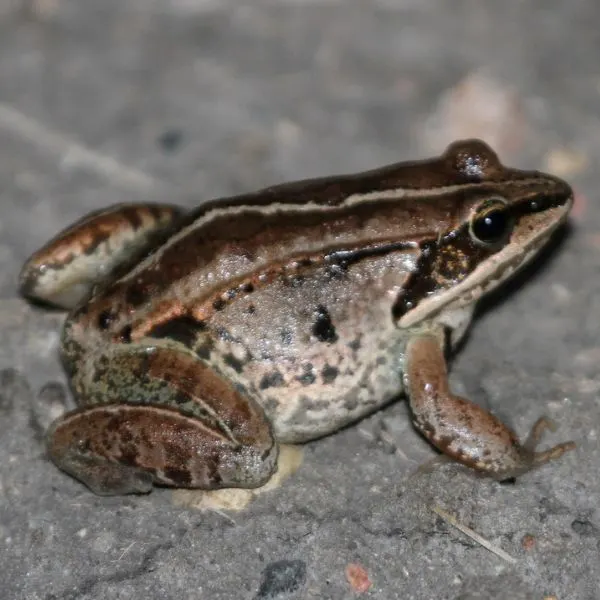
- Family: Ranidae
- Scientific Name: Lithobates sylvaticus
- Other Names: Rana sylvatica, the frog with the robber‘s mask
- Adult Size: 3.8 to 8.2 cm (1.5 to 3.25 in)
- Lifespan: 0 to 3 years in the wild, up to 5 years
Another species of frog in North Dakota is the wood frog. It is native to the Nearctic realm.
It is commonly distributed across North America, the United States, and Canada. It spends most of its time on the ground or around trees.
A frog of this species can be identified by the mask-like markings across its eyes. These markings give the frog its other common name. Also present is a black patch from each eardrum to the base of each foreleg.
A white outline can be noticed across its upper lip. Its dorsal color could be any shade of gray, green, brown, tan, or rust. It has a lateral mid-dorsal fold, usually bright yellow-brown in color. Ventrally, the frog is colored white.
Some sexual dimorphism can be seen in these frogs. Female wood frogs are more brightly colored dorsally than males. They are also bigger in size and their white bellies fade to a yellow-orange pallor towards the legs.
Males, on the other hand, are smaller in size, with the ventral part of their legs colorful and their dorsum colored darker. Frogs of this species are diurnal. The call of males sounds like the quacking of a duck or the squawking of a chicken.
They are cryptically adapted to their surroundings, blending with the forest floor to evade predators. They also produce poisons to irritate or harm them.
When captured, a wood frog lets out a piercing cry (alarm call) to startle its attacker.
Species of Toads in North Dakota
6. American Toad
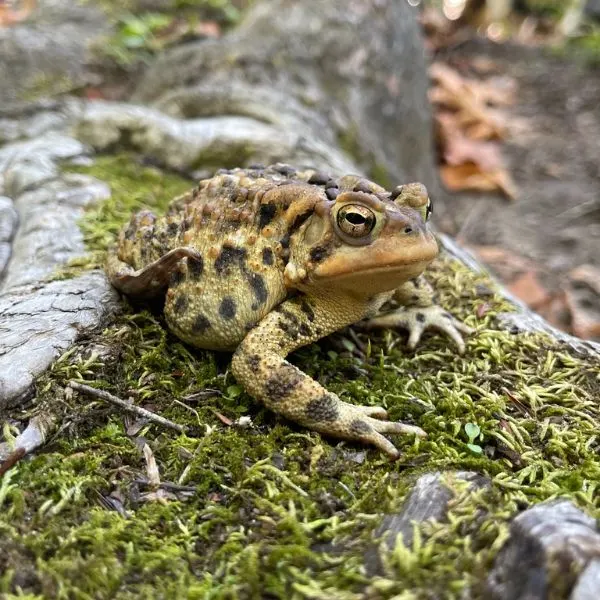
- Family: Bufonidae
- Scientific Name: Anaxyrus americanus
- Other Names: Bufo americanus, hop toad, east American toad
- Adult Size: 5 to 10 cm (1.97 to 4 in), average SVL of 7.5 cm (2.95 in)
- Lifespan: 1 to 10 years in the wild; up to 36 years in captivity
The American toad is easily the most common toad in North America.
It can be found in places across Canada, Mexico, and the eastern part of the United States. It inhabits rainforests, streams, ponds, and even backyards.
Toads of this species could live almost anywhere within this region, provided there is a body of semi-permanent water for them to breed in and thickset vegetation to cover them while they hunt around for food.
Two subspecies of the American toad exist Anaxyrus americanus americanus (Eastern American toad) and Anaxyrus americanus charlesmithi (dwarf American toad).
They are stout, with yellow or red warts on their skin. This thick dorsal skin is colored differently by each individual. Possible colors include olive green, gray, reddish brown, and tan. The skin could be solid colored or include patterns.
American toads have short legs and their wart patterns are different from those of other toads. Their backs are littered with dark spots, with each spot having one or two warts. They have black pupils with gold circles around them.
The females and males are easily distinguishable. While the male toads have longer throats and overall darker skin, the females possess shorter throats and are generally lighter skinned.
Also, the female toads grow to a larger size than males. Females are usually about 5.6 cm to 11 cm in length when fully grown. Males on the other hand are roughly 5.4 to 8.5 cm at maturity.
American toads are nocturnal but they show activity in warm and humid weather as well. The advertisement call of the male toads is a long, high pitched and neat-sounding trill, described as a musical bur-r-r-r-r-r-r that can last up to 30 seconds.
7. Canadian Toad
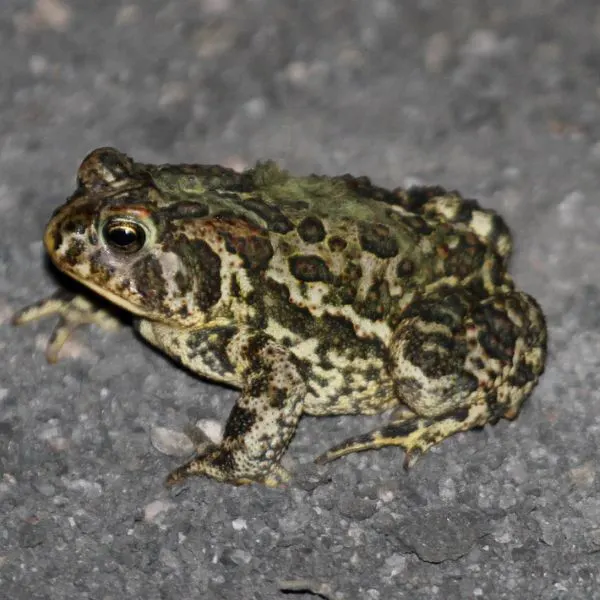
- Family: Bufonidae
- Scientific Name: Anaxyrus hemiophrys
- Other Names: Dakota toad
- Adult Size: 3.7 to 8.3 cm (1.5 to 3.25 in), 7.5 cm (3 in) on average
- Lifespan: N/A
The Canadian toad is endemic to Canada and the United States. It lives in the states and provinces of Minnesota, North Dakota, South Dakota, Wyoming, Alberta, Manitoba, and Saskatchewan.
Individual toads can be found living in areas with little to no vegetation. Habitats of residence include aspen parklands, boreal forests, grasslands, lakes, ponds, potholes, streams, and other regions with soft soil.
They resemble American toads in appearance. Dorsally, they are colored in several shades of tan, brown, gray, or pale green. Along the middle of the toads’ backs runs a narrow pale or white line.
Small to medium-sized spots dot the dorsal skin of the Canadian toad. Each of these dark spots has one or two large brown or red-orange warts on it. The ventral surface is white and mottled with black spots.
A boss, which is a raised and bony structure, is found between the eyes of this species. It is formed by the fusion of the cranial crests. The kidney-shaped or round parotid glands do not touch this boss.
Some dimorphism exists between the sexes. Males have dark nuptial pads on the first and second digits of their front legs for grasping females in amplexus. While they have dark throats, females have pale throats and lack nuptial pads.
Canadian toads are both diurnal and nocturnal, active on warm nights but primarily showing daytime activity. Males use a trilling sound as an advertisement call. It is harsher than that of American toads, lasting 3 to 6 seconds in length.
In addition to the toxins they produce from the parotid glands in their necks, they ward off or startle predators using a loud alarm call. Also, they inflate their bodies to make themselves hard to swallow or play dead when in danger.
8. Great Plains Toad

- Family: Bufonidae
- Scientific Name: Anaxyrus cognatus
- Other Names: Bufo cognatus
- Adult Size: 4.8 to 11.4 cm (1.9 to 4.5 in)
- Lifespan: up to 10.7 years in captivity
Another species of toad in North Dakota is the Great Plains toad. The toad is found in Canada, Mexico, and the USA. It is widely distributed and found in Alberta, Arizona, California, Colorado, Iowa, Kansas, Manitoba, and many other places.
Individuals can be found in damp sections of grasslands and arid areas. They have been found mostly living in temperate areas, deserts, savannas, temporary rain pools, reservoirs, and river floodplains.
They are average-sized, relatively large toads. They have small heads and their cranial crests are well developed, forming a “V” between the eyes. The snouts of this species are blunt and rounded.
The dorsal coloration on Great Plains toads is usually yellowish, greenish, brown, or gray. They may have a light and narrow mid-dorsal stripe along the length of their backs. Ventral coloration is cream to white without spots.
There are large dark blotches on their backs bordered in a halo-like manner, in the lighter pigments of white or cream. Each blotch has many warts on it. The skin is very rough because of these warts.
Great Plains toads are primarily nocturnal but sometimes show activity in the daytime. Their call is a high-pitched trill like that of American toads, but it is more mechanical and compelling. Like other toads, they are poisonous.
9. Plains Spadefoot

- Family: Scaphiopodidae
- Scientific Name: Spea bombifrons
- Other Names: American spadefoot, European spadefoot, Plains spadefoot toad
- Adult Size: 3.8 to 6.35 cm (1.5 to 2.5 in), record SVL 6.5 cm (2.56 in)
- Lifespan: up to 13 years
This species of toad range from southern Canada through the United States and into northern Mexico. They can be found in Iowa, Kansas, Montana, Nebraska, Nevada, Utah, Wyoming, Alberta, Manitoba, and Saskatchewan.
Plains spadefoots prefer to live in grasslands with loose soil to aid burrowing. On their heads, a pronounced round protuberance, also called a boss, can be noticed between the eyes. Their skin could be brown or gray with a greenish tinge.
Four vague longitudinal stripes may be noticed on their backs. Their warts are usually yellow or orange in color. However, their skin is smoother and moister than most toads’ skins, more like a frog’s skin.
Like on other species of spadefoots, there is a single tubercle on the hindleg of toads of this species. This tubercle, used for burrowing, is wedge-shaped and spade-like. The toes of these toads are webbed.
Plains spadefoots are nocturnal and are most active during the rains. This species is largely terrestrial. It is considered vulnerable, as it is quite common but individuals are rarely seen across its geographical range.
This toad has two distinct calls, both short and sounding like a duck. One is low-pitched and raspy like a snore, lasting for approximately one second. The other call is resonant and bleat-like, lasting for approximately half a second.
10. Woodhouse’s Toad
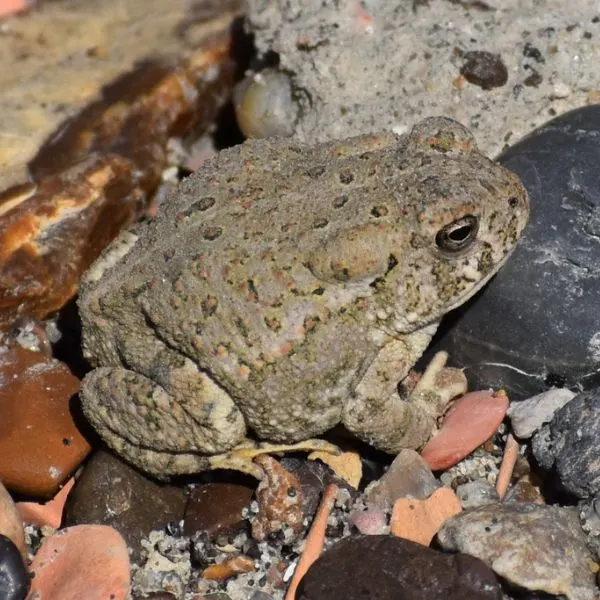
- Family: Bufonidae
- Scientific Name: Anaxyrus woodhousii
- Other Names: Bufo woodhousii
- Adult Size: 6 to 10 cm (2.4 to 3.94 in)
- Lifespan: 10 to 20 years, record longevity of 36 years
Woodhouse’s toads are found in several populations in states of the US including Arizona, California, Idaho, Louisiana, Montana, Nevada, New Mexico, North Dakota, Oregon, Texas, and Utah. They also live in Mexico.
They occur in different temporary, semi-permanent, and permanent water bodies. Moist meadows, ponds, irrigation ditches, temporary pools, grasslands, farms, desert streams, and golf courses are some habitats that house them.
On toads of this species, the dorsal coloration is usually gray, brown, olive, green, yellow-green, or yellow. Dark blotches are present on their backs also. A dorsolateral stripe running up to their snout is seen in white or whitish color.
Ventrally, Woodhouse’s toads are pale cream or beige in color. Individuals may have their bellies mottled or not. Black and yellow marks can be noticed towards the ventral groin and thigh areas.
These large toads have warty skin. Their cranial crests are very prominent. Sometimes, a protrusion touching the separate parotid glands can be noticed between these cranial crests.
Woodhouse’s toads are primarily nocturnal but they can be sometimes seen moving around in the daytime when they are not underground. Not much activity is noticed from them in the winter and so it is speculated that they hibernate.
Their call resembles a muted snore or the sound of a sheep bleating. It typically lasts 1 to 4 seconds. These toads move slowly, walking or crawling with short hops. Their defense is the poisonous secretions from their skin that deter predators.
FAQs
What frogs live in North Dakota?
There are five (5) kinds or species of frogs that live in North Dakota. These include boreal chorus frogs, Cope’s gray tree frogs, gray tree frogs, northern leopard frogs, and wood frogs.
What do frogs do in the winter in North Dakota?
In North Dakota and elsewhere, frogs, toads, and some other animals go into hibernation in the winter. Frogs and toads are ectothermic and so they apply this mechanism for preservation.
They go into a sleep-like state during the cold periods in order to avoid having to extend energy foraging for food and looking for warmth.
Does North Dakota have poisonous frogs?
Yes, North Dakota has poisonous frogs. However, they are only one species out of the ten: the wood frog.
Are there toads in North Dakota?
There are five (5) species of toads in North Dakota. These are American toads, Canadian toads, Great Plains toads, Plains spadefoot toads, and Woodhouse’s toads.
Conclusion
North Dakota’s ten (10) anuran species include five (5) kinds of frogs and five (5) kinds of toads. The major terrestrial biome of the state is temperate grassland (plains or prairies). It also includes several native, rural, and community forests.
Frogs and toads are of positive economical importance to man. They provide food for the animals that are eaten by the animals we eat, thereby feeding us. They also eat the insects that would be crops and household pests to man.
Several species are in abundance but some are threatened, endangered, or on the brink of extinction. Several reasons for this include habitat loss, disease, some activities of urbanization, and the introduction of predatory species.
Anurans are solitary animals. They are typically only seen in groups during the mating, breeding, or reproductive season (usually in the spring). In this time, males gather together and take breeding choruses to call out to females.
When females hear, they meet the males at breeding pools or ponds and then mate. Fertilization is external, except in tailed frogs (of the genus Ascaphus). Females lay eggs in water and males release sperm to fertilize the eggs.
After fertilization, like or no parental interest is shown. Only a number of eggs survive predation to grow into larvae and then into adulthood. When metamorphosis is completed, it takes about 1 to 3 years for the anuran to be sexually active.
Frogs that are not poisonous make good household pets, especially for children. This is because they are affordable, small, and easy to take care of. On the other hand, all toads are poisonous and so are not advisable to be kept as pets.
Nearby states
